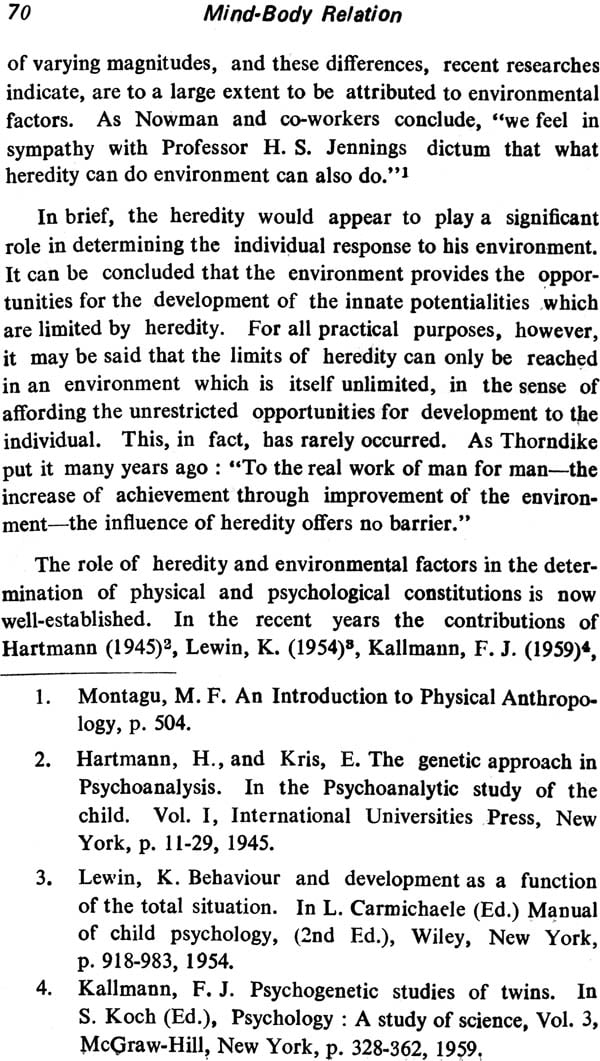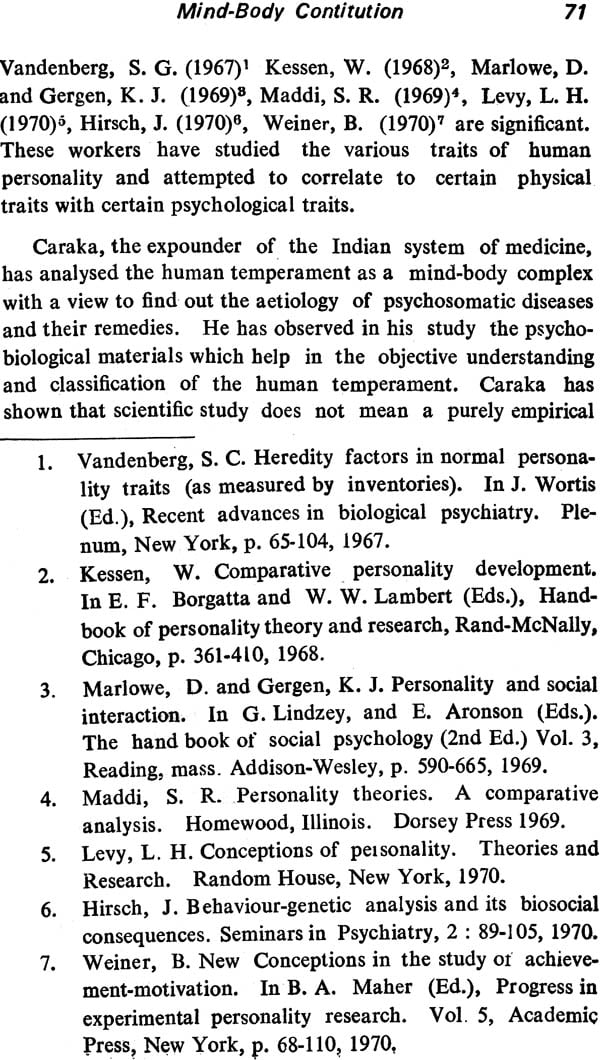
Mind-Body Relation in Indian Philosophy (An Old and Rare Book)
Book Specification
| Item Code: | NAK482 |
| Author: | D. Chaube |
| Publisher: | Tara Printing Works, Varanasi |
| Language: | English |
| Edition: | 1991 |
| Pages: | 167 |
| Cover: | Hardcover |
| Other Details | 8.5 inch X 5.5 inch |
| Weight | 290 gm |
Book Description
It gives me great pleasure in introducing Dr. Deo Brat Chaube's book on Mind-Body Relationship in Indian Philosophy to the reading .public. Dr. Chaube has laboured hard on the book, having consulted a wide variety of rich source- material on the said theme, and has managed to produce a scholarly treatise, which should be of benefit to all students of traditional Indian philosophy and psychology and to students of Indian Culture in general. I derived a great deal of benefit after perusing through the work, the value of which, in my opinion, lies in the wide range of the problems covered by Dr. Chaube and his criticism on each aspect of the problem as dealt with by the traditional Indian thinkers on the subject.
Many students of philosophy and psychology are aware only of the Western treatment of the topic. In traditional European philosophy, the problem of mind-body relationship has been dealt with under the heads Inter-actionaism, Parallelism, Occasionalism, Epi-phenomenalism etc., all of which have been superseded by modern Psychological and philosophical theories. In particular, psycho-analysis behaviourism and gestalt psychology have made remarkable contribution in attempting a resolution of the problem, though as every student of cpntemporary philosophy knows, there has been a negative approach to the problem, which has been left more or less unresolved.
It is here that Indian ways of thinking can produce positive contribution to the solution of the problem. Dr. Chaube's own analysis makes this is me more than clear. His exposition of the problem as dealt within traditional Indian schools of philosophy, in particular by Samkhya-Yoga schools and by the writers on Indian system of medicine is expounded by Caraka and Susruta. The entire system of Ayurveda is based on what Chaube has correctly described as the pscho-somatic approach, without which the problems of illness and its cure cannot be resolved satisfactorily. Recent medical research has shown how correct this approach is. Separation of the body from mind does pose difficulties which are not easy to surmount.
Dr. Chaube has dealt with subsidiary conceptual problems of Indian philosophy like 'consciousness', 'soul', 'self' gross and subtle body etc. in the manner of an expert scholar. I consider this work as a highly useful addition to the literature on the mind-body problem in Indian philosophy. One is aware that research on this topic is quite sparse, as most of the work available relates to the Vedanta philosophy. Dr. Chaube has explored new avenue of knowledge, which must receive a very wide attention of students and scholars in the field of Indian philosophy. I congratulate Dr. Deo Brat Chaube on his excellent achievement.
The present work is an attempt to understand the mind- body relationship from the standpoint of Indian philosophy. All the schools of Indian philosophy have considered this issue from the very ancient times. Recent developments in psychological experiences and advances in scientific methods have made the problem even more challenging than what it was in the past. The problem of the relation of mind and body is no special problem in Indian philosophy because Indian thinkers do not equate mind with the self. In Indian philosophy the word mind is used in the sense of manas or antahkarana (internal organ) and not in the sense of atman (self). We have also used the word mind for the manas or internal organ and not for the self.
The word manas is used in many places in the Vedic texts. It has been used in the sense of measuring. It is an organ of research, it symbolises the rational faculty in man. For the maintenance of good health there are prayers done for man as which is essential for physical growth. Maintenance of psyche contributes to life, and death is associated with the dissolution of manas. Mind is concerned with samkalpa. This word has appeared only in the late passage of Rgveda. In Rgveda we read of mind as the cosmic principle which desire is said to be the creative energy. In the Vajasaneya samhita mind appears as a psychical faculty. It is characterised as "that which goes out afar and as the swiftest." In Buddhism also mind is very fickle and unsteady.
There is a disputed question in Indian philosophy whether the mind is a sense-organ or not? Almost all the systems of Indian philosophy regard the mind as a sense organ. Jaina does not regard mind as a sense-organ. Mind is subtle matter. It plays a very important role in the perception. In the absence of mind there is no cognition. Sruti clearly declares that man does not see the things in the absence of mind. It is the controller o£ all the senses. Mind is the cause of bondage and liberation.
The concept of body is well defined in different systems of Indian philosophy. It is of fundamental importance as much for a correct conception of the self and the world, as for a philosophical control of life. According to Nyaya it is the abode of enjoyment. The body could not exist without the senses, and the senses require the support of a body. Our knowledge of the world depends on the number and nature of the sense-organ. The Indian thinkers believe that there is not only the gross body with which we are generally acquainted, but we also possess the subtle body and causal body of the soul. According to Samkhya philosophy the subtle body is the combination of buddhi, ahamkara, eleven senses and tanmatras. According to the Vedanta philosophy the subtle body is made up of the five organs of action, mind, intellect and five vital airs. It is transparent, therefore at the time of migration of the Jiva, it is not seen by the naked eyes.
The Vedanta agrees with regard to the existence of the causal body. It is the cause of subtle body and gross body. It consists of the basic-consciousness of 'I'-ness.
In the present work a thought has also been given to the Ayurvedic view. Caraka-samhita is the most important ancient classical work on Ayurveda. For its fundamental concept it is mainly based on the Sarpkhya and Nyaya- Vaisesika system of Indian philosophy. The most important contribution of Caraka is to apply philosophical concepts in order to maintain normal physical and mental health, so that man can perform four-fold objective of life. Ayurveda also believes in the reciprocal effect of mind on body and vice- versa, thereby proving the intimate relationship of the mind and body.
Long draw attempts have been made to solve the mind- body problem. The problem arises because some Western thinkers differentiate mind from body on the one hand and equate mind with the self on the other hand. In the West one of the conceivable solutions of this problem is interactionism. It holds that states of mind can be causally affected by states of the body and states of the body can be causally affected by the states of mind. Thus the mental and bodily states interact. It may be said that the adoption of interactionism constitutes a solution to the mind-body problem. Here a question arises, if the stuff of mind is so different from the stuff of body, then how do they influence one another 'I It is evident that this acceptance would not solve the mind-body problem. The ordinary difficulty as to how two entirely different entities come in contact with each other vanishes when we look at the point from Yoga perspective. According to Yoga philosophy also there is interactionism between the mind and body. But in Yoga philosophy mind is not different from the body. Mind and body both come under the same category. Like things can act upon each other. In modern physics, the action of bodies upon bodies is mediated by gravitational and electrical fields. Thus the difficulty of mind-body interaction does not arise from the point of view of Yoga philosophy. Caraka, the propounder of Ayurveda, also supports the theory of interactionism. Like Yoga, Caraka has also accepted the continuity between mind and body because both have the same origin and nature. They are related with each other. The mind is dependent upon the body and body is dependent on the mind. The mind-body interactionism may be proved by studying the nidana (causes) of various physical and mental disorders. According to Ayurvedika system of medicine, no disease can essentially develop without the interaction of the mind and body.
The theory of materialism solves the mind-body problem by denying the existence of mind. According to materialistic thinkers there is no mind, but only body. Mind is a special part of the body. According to Smart there is nothing in the world over and above those entities which are postulated by physics. Materialism assumes that the only entities existing in the world are atoms, aggregates of atoms and that the only properties and relations are the properties of, and the relations between such aggregates. Matter is the reality and mind is a more property of protoplasm, The current theories also suggest that the evolution and the development of the body come before the evolution and development of the mind. The Carvakas, like the Western materialists, also do not believe in the separate existence of mind from the physical body. According to them, the mind or consciousness is merely a product of the combination of elements, just as the wines are the result of chemical combination. All the thoughts, sensation and emotions are physical in nature. It is the material body that feels, remembers the things and feels happiness and sorrow. According to Joseph Priestley, the sensation and thought were regarded as functions of the brain.
The Samkhya solves the mind-body problem by the theory of transformationism. According to this theory the mind and body both are the transformation of prakr1i. The substance is the same in finer or grosser form, one changes into other and this exactly coincides with the conclusions of modern physiological research. The constituent elements of the manifold objects in the universe, physical and mental, are the same, and the Samkhya clearly declares that it is possible for one element to change into other. Prakrti is capable of existing in several forms. Prakrti which is the first state of everything and which begins to change in the same as milk becomes curd. Mind and body both represent different orders of development. Though they are fundamentally one, they are practically different. Therefore they serve different purposes.
| Foreword | ||
| Introduction | ||
| Acknowledgments | ||
| 1 | The Concept of Mind | 1-26 |
| 2 | The Concept of Body | 27-54 |
| 3 | Mind-Body Constitution | 55-79 |
| 4 | Mind-Body Relation In Indian Philosophy | 80-116 |
| 5 | Mind-Body Relationship In Carak-Samhita | 117-137 |
| 6 | Conclusion | 138-143 |
| 7 | Bibliography | 144-151 |







